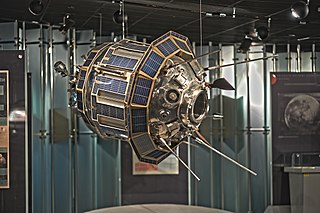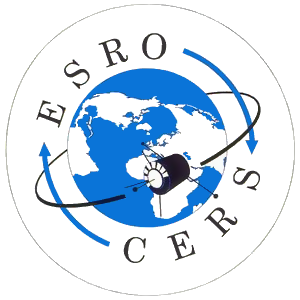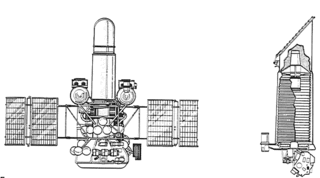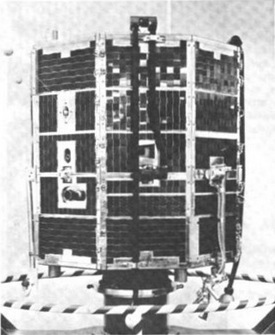Related Research Articles

Luna 1, also known as Mechta, E-1 No.4 and First Lunar Rover, was the first spacecraft to reach the vicinity of Earth's Moon, the first spacecraft to leave Earth's orbit, and the first to be placed in heliocentric orbit. Intended as a Moon impactor, Luna 1 was launched as part of the Soviet Luna programme in 1959.

Luna 2, originally named the Second Soviet Cosmic Rocket and nicknamed Lunik 2 in contemporaneous media, was the sixth of the Soviet Union's Luna programme spacecraft launched to the Moon, E-1 No.7. It was the first spacecraft to reach the surface of the Moon, and the first human-made object to make contact with another celestial body.

Luna 3, or E-2A No.1, was a Soviet spacecraft launched in 1959 as part of the Luna programme. It was the first mission to photograph the far side of the Moon and the third Soviet space probe to be sent to the neighborhood of the Moon. The historic, never-before-seen views of the far side of the Moon caused excitement and interest when they were published around the world, and a tentative Atlas of the Far Side of the Moon was created from the pictures.

Mars 1, also known as 1962 Beta Nu 1, Mars 2MV-4 and Sputnik 23, was an automatic interplanetary station launched in the direction of Mars on November 1, 1962, the first of the Soviet Mars probe program, with the intent of flying by the planet at a distance of about 11,000 km (6,800 mi). It was designed to image the surface and send back data on cosmic radiation, micrometeoroid impacts and Mars' magnetic field, radiation environment, atmospheric structure, and possible organic compounds.

Phobos 1 was an uncrewed Soviet space probe of the Phobos Program launched from the Baikonour launch facility on 7 July 1988. Its intended mission was to explore Mars and its moons Phobos and Deimos. The mission failed on 2 September 1988 when a computer malfunction caused the end-of-mission order to be transmitted to the spacecraft. At the time of launch it was the heaviest interplanetary spacecraft ever launched, weighing 6200 kg.

The R-1 rocket was a tactical ballistic missile, the first manufactured in the Soviet Union, and closely based on the German V-2 rocket. The R-1 missile system entered into service in the Soviet Army on 28 November 1950. Deployed largely against NATO, it was never an effective strategic weapon. Nevertheless, production and launching of the R-1 gave the Soviets valuable experience which later enabled the USSR to construct its own much more capable rockets.

Fobos-Grunt or Phobos-Grunt was an attempted Russian sample return mission to Phobos, one of the moons of Mars. Fobos-Grunt also carried the Chinese Mars orbiter Yinghuo-1 and the tiny Living Interplanetary Flight Experiment funded by the Planetary Society.
The Committee on Space Research (COSPAR) was established on October 3, 1958 by the International Council for Scientific Unions (ICSU) and its first chair was Hildegard Korf Kallmann-Bijl. Among COSPAR's objectives are the promotion of scientific research in space on an international level, with emphasis on the free exchange of results, information, and opinions, and providing a forum, open to all scientists, for the discussion of problems that may affect space research. These objectives are achieved through the organization of symposia, publication, and other means. COSPAR has created a number of research programmes on different topics, a few in cooperation with other scientific Unions. The long-term project COSPAR international reference atmosphere started in 1960; since then it has produced several editions of the high-atmosphere code CIRA. The code "IRI" of the URSI-COSPAR working group on the International Reference Ionosphere was first edited in 1978 and is yearly updated.

The European Space Research Organisation (ESRO) was an international organisation founded by 10 European nations with the intention of jointly pursuing scientific research in space. It was founded in 1964. As an organisation ESRO was based on a previously existing international scientific institution, CERN. The ESRO convention, the organisations founding document outlines it as an entity exclusively devoted to scientific pursuits. This was the case for most of its lifetime but in the final years before the formation of ESA, the European Space Agency, ESRO began a programme in the field of telecommunications. Consequently, ESA is not a mainly pure science focused entity but concentrates on telecommunications, earth observation and other application motivated activities. ESRO was merged with ELDO in 1975 to form the European Space Agency.

Astron was a Soviet space telescope launched on 23 March 1983 at 12:45:06 UTC, using the Proton launcher. Based on the 4MV spacecraft design and operational for six years, Astron was the largest ultraviolet space telescope of its time.

Viking was Sweden's first satellite. It was launched on an Ariane 1 rocket as a piggyback payload together with the French satellite SPOT 1, on February 22, 1986. Operations ended on May 12, 1987. Viking was used to explore plasma processes in the magnetosphere and the ionosphere.

Kosmos 605 or Bion 1, was a Bion satellite. It was the first of eleven Bion satellites launched between 1973 and 1996.

Kosmos 110 was a Soviet spacecraft launched on 22 February 1966 from the Baikonur Cosmodrome aboard a Voskhod rocket. It carried two dogs, Veterok ("Breeze") and Ugolyok. It was one of the more eye-catching and popular experiments of the long series of Russian Kosmos satellites.

Kosmos-2251 was a Russian Strela-2M military communications satellite. It was launched into Low Earth orbit from Site 132/1 at the Plesetsk Cosmodrome at 04:17 UTC on 16 June 1993, by a Kosmos-3M carrier rocket.· The Strela satellites had a lifespan of 5 years, and the Russian government reported that Kosmos-2251 ceased functioning in 1995. Russia was later criticised by The Space Review for leaving a defunct satellite in a congested orbit, rather than deorbiting it. In response, Russia noted that they were not required to do so under international law. In any case, the KAUR-1 satellites had no propulsion system, which is usually required for deorbiting.

Space research is scientific study carried out in outer space, and by studying outer space. From the use of space technology to the observable universe, space research is a wide research field. Earth science, materials science, biology, medicine, and physics all apply to the space research environment. The term includes scientific payloads at any altitude from deep space to low Earth orbit, extended to include sounding rocket research in the upper atmosphere, and high-altitude balloons.
Brian Harvey is a space writer, author and broadcaster who lives in Ireland, Brian Harvey has long written about China's space program as well as the space programs of India and Japan. He has written articles on spaceflight from the 1970s in such magazines as Orbit, Astronomy and Space, Go Taikonauts! and Spaceflight and for newspapers such as the Sunday Press and the Irish Independent. His articles have been published in Astronomy Now, Space Quarterly, Space Policy, ROOM, the Journal of the British Interplanetary Society, Space Chronicle, Zenit and Quest.

David John McComas is an American space physicist, Vice President for Princeton Plasma Physics Laboratory, and Professor of Astrophysical Sciences and leads the Space Physics at Princeton Group at Princeton University. He had been Assistant Vice President for Space Science and Engineering at the Southwest Research Institute, Adjoint Professor of Physics at the University of Texas at San Antonio (UTSA), and was the founding director of the Center for Space Science and Exploration at Los Alamos National Laboratory. He is noted for his extensive accomplishments in experimental space plasma physics, including leading instruments and missions to study the heliosphere and solar wind: IMAP, IBEX, TWINS, Ulysses/SWOOPS, ACE/SWEPAM, and Parker Solar Probe. He received the National Academy of Science's 2023 Arctowski Medal, European Geosciences Union 2022 Hannes Alfven Medal, SCOSTEP 2022 Distinguished Scientist Award, a NASA Exceptional Public Service Medal in 2015, the 2014 COSPAR Space Science Award, and the American Geophysical Union 1993 Macelwane Medal.
Dr. Robert E. Huffman (1931–2008) was an American space scientist and author. He specialized in ultraviolet spectroscopy in the earth's upper atmosphere. Working for the United States Air Force, Dr. Huffman managed the Horizon Ultraviolet Program (HUP) experiments on two Space Shuttle flights: Columbia and Discovery.

The KAUR program was a series of satellite buses designed and manufactured by ISS Reshetnev. Its design is based on a pressurized bus originally developed in the 1960s and has been used from low Earth Orbit to medium Earth orbit and even to GEO. It has four different generations and its different versions have been used from civilian communications to satellite navigation.

Orbiting Vehicle 3-2, launched 28 October 1966, was the fourth satellite to be launched in the OV3 series of the United States Air Force's Orbiting Vehicle program. The satellite measured charged particles in orbit, mapping irregularities in the ionosphere, particularly the auroral zone. OV3-2 reentered the Earth's atmosphere on 29 September 1971.
References
- ↑ Brian Harvey; Olga Zakutnyaya (4 May 2011). Russian Space Probes: Scientific Discoveries and Future Missions. Springer Science & Business Media. pp. 427–. ISBN 978-1-4419-8150-9.
- ↑ Soviet Journal of Plasma Physics. American Institute of Physics. 1992.
- ↑ Brian Harvey; Olga Zakutnyaya (4 May 2011). Russian Space Probes: Scientific Discoveries and Future Missions. Springer Science & Business Media. pp. 430–. ISBN 978-1-4419-8150-9.
- ↑ COSPAR. Plenary Meeting; Roy Banks Torbert; COSPAR. Interdisciplinary Scientific Commission D. (31 July 1992). Active experiments in space: proceedings of the Topical Meeting of the COSPAR Interdisciplinary Scientific Commission D (Meeting D3) of the COSPAR Twenty-eighth Plenary Meeting held in The Hague, The Netherlands, 25 June-6 July 1990. Published for the Committee on Space Research by Pergamon Press. ISBN 9780080420431.